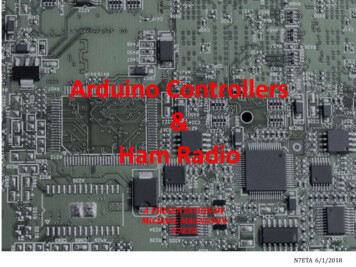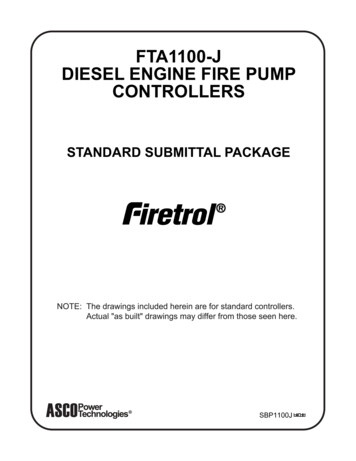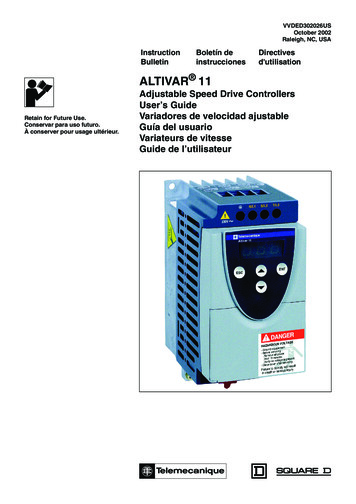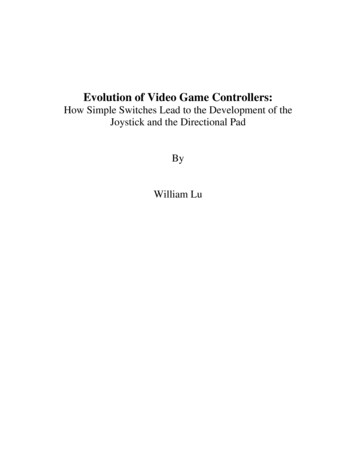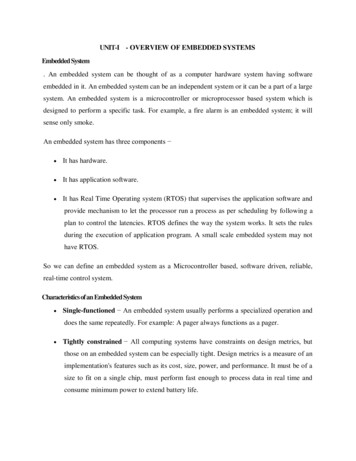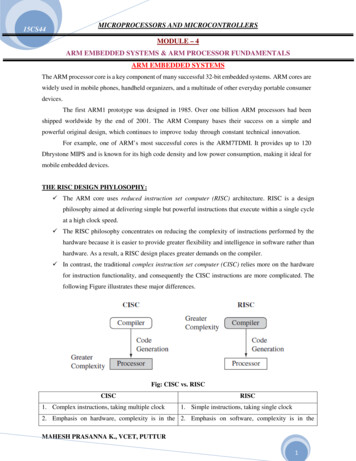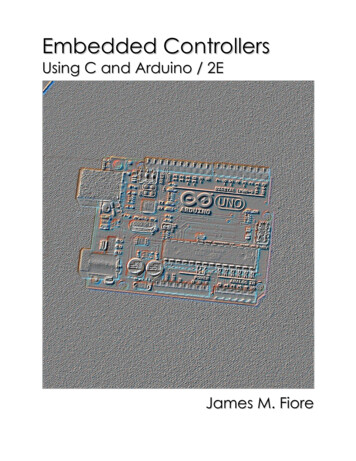
Transcription
Embedded ControllersUsing C and Arduino / 2EJames M. Fiore
2Embedded Controllers
Embedded ControllersUsing C and ArduinobyJames M. FioreVersion 2.1.10, 07 May 2021Embedded Controllers3
This Embedded Controllers Using C and Arduino, by James M. Fiore is copyrighted under the terms of aCreative Commons license:This work is freely redistributable for non-commercial use, share-alike with attributionPublished by James M. Fiore via dissidentsISBN13: 978-1796854879For more information or feedback, contact:James Fiore, ProfessorElectrical Engineering TechnologyMohawk Valley Community College1101 Sherman DriveUtica, NY 13501jfiore@mvcc.eduoer@jimfiore.orgFor the latest revisions, related titles, and links to low cost print versions, go to:www.mvcc.edu/jfiore or my mirror sites www.dissidents.com and www.jimfiore.orgYouTube Channel: Electronics with Professor FioreCover art by the author4Embedded Controllers
IntroductionThis text is designed to introduce and expand upon material related to the C programming language andembedded controllers, and specifically, the Arduino development system and associated Atmel ATmegamicrocontrollers. It is intended to fit the time constraints of a typical 3 to 4 credit hour course forelectrical engineering technology and computer engineering technology programs, although it could alsofit the needs of a hardware-oriented course in computer science. As such, the text does not attempt tocover every aspect of the C language, the Arduino system or Atmel AVR microcontrollers. The firstsection deals with the C language itself. It is assumed that the student is a relative newcomer to the Clanguage but has some experience with another high level language, for example, Python. This meansconcepts such as conditionals and iteration are already familiar and the student can get up and runningfairly quickly. From there, the Arduino development environment is examined.Unlike the myriad Arduino books now available, this text does not simply rely on the Arduino libraries.As convenient as the libraries may be, there are other, sometimes far more efficient, ways ofprogramming the boards. Many of the chapters examine library source code to see “what’s under thehood”. This more generic approach means it will be easier for the student to use other processors anddevelopment systems instead of being tightly tied to one platform.All Atmel schematics and data tables are derived from the published version of the Atmel 328Pdocumentation which may be found at P Thisserves as the final word on the operation and performance of the 328P and all interested parties shouldbecome familiar with it.There is a companion laboratory manual to accompany this text. Other OER (Open Educational Resource)laboratory manuals in this series include Computer Programming with Python, and Science of Sound.OER texts and laboratory manuals are available for Operational Amplifiers & Linear Integrated Circuits,Semiconductor Devices, DC Electrical Circuit Analysis and AC Electrical Circuit Analysis. Please checkmy web sites for the latest versions.A Note from the AuthorThis text is used at Mohawk Valley Community College in Utica, NY, for our ABET accredited AASprogram in Electrical Engineering Technology. Specifically, it is used in our second year embeddedcontrollers course. I am indebted to my students, co-workers and the MVCC family for their support andencouragement of this project. While it would have been possible to seek a traditional publisher for thiswork, as a long-time supporter and contributor to freeware and shareware computer software, I havedecided instead to release this using a Creative Commons non-commercial, share-alike license. Iencourage others to make use of this manual for their own work and to build upon it. If you do add to thiseffort, I would appreciate a notification.“When things get so big, I don’t trust them at allYou want some control-you gotta keep it small”- Peter GabrielEmbedded Controllers5
6Embedded Controllers
Table of Contents1. Course Introduction.82. C Memory Organization.103. C Language Basics.144. C Language Basics II.245. C Storage Types and Scope .326. C Arrays and Strings.367. C Conditionals and Looping .408. C Pointers and Addresses.489. C Look-Up Tables.52.10. C Structures.5611. C Linked Lists*.6012. C Memory*.64.6814. C Command Line Arguments*.7215. Embedded Programming.7416. Hardware Architecture .7817. AVR ATmega 328P Overview**.8418. Bits & Pieces: includes and defines.9019. Bits & Pieces: Digital Output Circuitry .9820. Bits & Pieces: Digital Input Circuitry.10221. Bits & Pieces: pinMode .10622. Bits & Pieces: digitalWrite.11223. Bits & Pieces: delay.116.12425. Bits & Pieces: Analog Input Circuitry .13226. Bits & Pieces: analogRead.13627. Bits & Pieces: analogWrite.14228. Bits & Pieces: Timer/Counters .14629. Bits & Pieces: Interrupts .154Appendices .160Index .16513. C File I/O*.24. Bits & Pieces: digitalRead.* Included for language coverage but seldom used for small to medium scale embedded work.** Including modest comic relief for film noir buffs.Embedded Controllers7
1. Course Introduction1.1 OverviewThis course introduces the C programming language and specifically addresses the issue of embeddedprogramming. It is assumed that you have worked with some other high level language before, such asPython, BASIC, FORTRAN or Pascal. Due to the complexities of embedded systems, we begin with atypical desktop system and examine the structure of the language along with basic examples. Once wehave a decent grounding in syntax, structure, and the development cycle, we switch over to an embeddedsystem, namely an Arduino based development system.This course is designed so that you can do considerable work at home with minimal cost if you choose to(this is entirely optional, but programming these little beasties can be addicting so be forewarned). Alongwith this course text and the associated lab manual, you will need an Arduino Uno board (about 25) anda USB host cable. A small “wall wart” power adapter for it may also be useful. There’s a lot of free Cprogramming info on the Internet but if you prefer print books and want more detail, you may also wishto purchase one of the many C programming texts available. Two good titles are Kochan’s bookProgramming in C and the one by Deitel & Deitel, C-How to Program. Whichever book you choose,make sure that its focus is C and not C . You will also need a desktop C compiler. Just about any willdo, including Visual C/C , Borland, CodeWarrior, or even GCC. A couple of decent freeware compilersavailable on the Internet include Pelles C and Miracle C.1.2 Frequently Asked QuestionsWhy learn C language programming?C is perhaps the most widely used development language today. That alone is a good reason toconsider it but there’s more: It is a modern structured language that has been standardized (ANSI).It is modular, allowing reuse of code.It is widely supported, allowing source code to be used for several different platforms by justrecompiling for the new target.Its popularity means that several third-party add-ons (libraries and modules) are available to“stretch” the language.It has type checking which helps catch errors.It is very powerful, allowing you to get “close to the metal”.Generally, it creates very efficient code (small space and fast execution).What’s the difference between C and C ?C is a superset of C. First came C, then came C . In fact, the name C is a programmer’s jokebecause is the increment operator in C. Thus, C literally means “increment C”, or perhaps “giveme the next C”. C does everything C does plus a whole lot more. These extra features don’t comefree and embedded applications usually cannot afford the overhead. Consequently, although much8Embedded Controllers
desktop work is done in C as well as C, most embedded work is done in C. Desktop developmentsystems are usually referred to as C/C systems meaning that they’ll do both. Embeddeddevelopment systems may be strictly C or even a variant of it (as is ours).Where can I buy an Arduino development board?The Arduino Uno board is available from a variety of sources including Digi-Key, Mouser, PartsExpress and others. Shop around!What’s the difference between desktop PC development and embeddedprogramming?Desktop development focuses on applications for desktop computers. These include things like wordprocessors, graphing utilities, games, CAD programs, etc. These are the things most people think ofwhen they hear the word “computer”. Embedded programming focuses on the myriad nearly invisibleapplications that surround us every day. Examples include the code that runs your microwave oven,automobile engine management system, cell phone, and many others. In terms of total units,embedded applications far outnumber desktop applications. You may have one or even a few PCs inyour house but you probably use dozens of embedded applications every day. Embeddedmicrocontrollers tend to be much less powerful but also much less expensive than their PCcounterparts. The differing programming techniques are an integral part of this course and we shallspend considerable time examining them.How does C compare with Python?If, like many students taking this course, your background is with the Python language, you may findcertain aspects of C a little odd at first. Some of it may seem overly complicated. Do not be alarmedthough. The core of the language is actually simple. Python tends to hide things from the programmerwhile C doesn’t. Initially, this seems to make things more complicated, and it does for the mostsimple of programs, but for more complicated tasks C tends to cut to the heart of the matter. Manykinds of data and hardware manipulation are much more direct and efficient in C than in otherlanguages. One practical consideration is that C is a compiled language while most versions ofPython are essentially interpreted. This means that there is an extra step in the development cycle, butthe resulting compiled program is much more efficient. We will examine why this is so a little later.How does C compare with assembly language?Assembly has traditionally been used when code space and speed are of utmost importance. Yearsago, virtually all embedded work was done in assembly. As microcontrollers have increased in powerand the C compilers have improved, the tables have turned. The downside of assembly now weighsagainst it. Assembly is processor-specific, unstructured, not standardized, nor particularly easy to reador write. C now offers similar performance characteristics to assembly but with all the advantages of amodern structured language.Embedded Controllers9
2. C Memory Organization2.1 IntroductionWhen programming in C, it helps if you know at least a little about the internal workings of simplecomputer systems. As C tends to be “close to the metal”, the way in which certain things are performed aswell preferred coding techniques will be more apparent.First off, let’s narrow the field a bit by declaring that we will only investigate a fairly simple system, thesort of thing one might see in an embedded application. That means a basic processor and solid statememory. We won’t worry about disk drives, monitors, and so forth. Specific details concerning controllerarchitecture, memory hardware and internal IO circuitry are covered in later chapters.2.2 Guts 101A basic system consists of a control device called a CPU (central processing unit), microprocessor, ormicrocontroller. There are subtle distinctions between these but we have little need to go very deep at thispoint. Microcontrollers tend not to be as powerful as standard microprocessors in terms of processingspeed but they usually have an array of input/output ports and hardware functions (such as analog-todigital or digital-to-analog converters) on chip that typical microprocessors do not. To keep things simplewe shall use the term “processor” as a generic.Microprocessors normally are connected to external memory ( RAM chips). Microcontrollers generallycontain sufficient on-board memory to alleviate this requirement but it is worthwhile to note that we arenot talking about large (megabyte) quantities. A microcontroller may only contain a few hundred bytes ofmemory but in simple applications that may be sufficient. Remember, a byte of memory consists of 8 bits,each bit being thought of as a 1/0, high/low, yes/no, or true/false pair.In order for a processor to operate on data held in memory, the data must first be copied into a processor’sregister (it may have dozens of registers). Only in a register can mathematical or logical operations becarried out. For example, if you desire to add one to a variable, the value of the variable must first becopied into a register. The addition is performed on the register contents yielding the answer. This answeris then copied back to the original memory location of the variable. It seems a little roundabout at first,but don’t worry, the C language compiler will take care of most of those details for you.2.3 Memory MapsEvery byte of memory in a computer system has an address associated with it. This is a requirement.Without an address, the processor has no way of identifying a specific location in memory. Generally,memory addressing starts at 0 and works its way up, although some addresses may be special or“reserved” in some systems. That is, a specific address might not refer to normal memory, but insteadmight refer to a certain input/output port for external communication. Very often it is useful to draw amemory map. This is nothing more than a huge array of memory slots. Some people draw them with thelowest (starting) address at the top and other people draw them with the lowest address at the bottom.10Embedded Controllers
Here’s an example with just six bytes of memory:address 0address 1address 2address 3address 4address 5Figure 2.1, simple memory mapEach address or slot represents a place we can store one byte. If we had to remember specific addresseswe would be doing a lot of work. Instead, the C compiler will keep track of this for us. For example, if wedeclare a char named X, it might be at address 2. If we need to print that value, we don’t have to say“fetch the value at address 2”. Instead we say; “fetch the value of X” and the compiler generates code tomake this work out to the proper address (2). This abstraction eases our mental burden considerably. Asmany variables require more than one byte, we may need to combine addresses to store a single value.For example, if we chose a short int, that needs two bytes. Suppose this variable starts at address 4. Itwill also require the use of address 5. When we access this variable the compiler automatically generatesthe code to utilize both addresses because it “knows” we’re using a short int. Our little six bytememory map could hold 6 char, 3 short int, 1 long int with 1 short int, 1 long int with 2char, or some other similar combination. It cannot hold a double as that requires 8 bytes. Similarly, itcould not hold an array of 4 or more short int (see Chapter Three for details on numeric data types).Arrays are of special interest as they must be contiguous in memory. For example, suppose a system has1000 bytes of memory and a 200 element char array was declared. If this array starts at address 500 thenall of the slots from 500 through 699 are allocated for the array. It cannot be created in “scattered” fashionwith a few bytes here and a few bytes there. This requirement is due to the manner in which arrays areindexed (accessed), as we shall see later.2.4 StacksMany programs need only temporary storage for certain variables. That is, a variable may only be usedfor a limited time and then “thrown away”. It would be inefficient to allocate permanent space for thissort of variable. In its place, many systems use a stack. Ordinarily, an application is split into two parts, acode section and a data section. The data section contains the “permanent” (global) data. As these twowill not consume the entire memory map, the remainder of the memory is often used for temporarystorage via a stack. The stack starts at the opposite end of the memory map and grows toward the codeand data sections. It is called a First-In-Last-Out stack or FILO stack. It works like a stack of trays in acafeteria. The first tray placed on the stack will be the last one pulled off and vice versa. When temporaryEmbedded Controllers11
variables are needed, this memory area is used. As more items are needed, more memory is taken up. Asour code exits from a function, the temporary (auto) variables declared there are no longer needed, andthe stack shrinks. If we make many, many function calls with many, many declared variables, it ispossible for the stack to overrun the code and data sections of our program. The system is now corrupt,and proper execution and functioning of the program are unlikely.address 0area used by code and dataarea currently unused stack area, grows toward address 0address 65,535Figure 2.2, basic memory layoutAbove is a memory map example of a system with 64k bytes of memory (k 1024 or 2 10). Individualmemory slots are not shown. Only the general areas are shown.It is worthwhile to note that in some systems, code and data are in a common area as shown (VonNeumann architecture) while in others they are physically split (Harvard architecture). Whether split ornot, the basic concepts remain. So, why would we want to split the two areas, each accessed via its ownmemory bus1? Simple, separating the code and data allows the processor to fetch the next instruction(code) using a memory bus that is physically separate from the data bus it is currently accessing. A sharedcode/data memory bus would require special timing to coordinate this process as only one thing can be onthe bus at any given time. Having two separate memory buses will speed execution times.1A bus typically refers to a collection of wires or connections upon which multiple data bits (or address bits) are sentas a group.12Embedded Controllers
Embedded Controllers13
3. C Language Basics3.1 IntroductionC is a terse language. It is designed for professional programmers who need to do a lot with a little codequickly. Unlike BASIC or Python, C is a compiled language. This means that once you have written aprogram, it needs to be fed into a compiler that turns your C language instructions into machine code thatthe microprocessor or microcontroller can execute. This is an extra step, but it results in a more efficientprogram than an interpreter. An interpreter turns your code into machine language while it’s running,essentially a line at a time. This results in slower execution. Also, in order to run your program on anothermachine, that machine must also have an interpreter on it. You can think of a compiler as doing thetranslation all at once instead of a line at a time.Unlike many languages, C is not line oriented, but is instead free-flow. A program can be thought of asconsisting of three major components: Variables, statements and functions. Variables are just places tohold things, as they are in any other language. They might be integers, floating point (real) numbers, orsome other type. Statements include things such as variable operations and assignments (i.e., set x to 5times y), tests (i.e., is x more than 10?), and so forth. Functions contain statements and may also call otherfunctions.3.2 Variable Naming, Types and DeclarationVariable naming is fairly simple. Variable names are a combination of letters, numerals, and theunderscore. Upper and lower case can be mixed and the length is typically 31 characters max, but theactual limit depends on the C compiler in use. Further, the variable name cannot be a reserved (key) wordnor can it contain special characters such as . ; , * - and so on. So, legal names include things like x,volts, resistor7, or even I Wanna Go Home Now.C supports a handful of variable types. These include floating point or real numbers in two basic flavors:float, which is a 32 bit number, and double, which is a higher precision version using 64 bits. Thereare also a few integer types including char, which is 8 bits, short int, which is 16 bits, and longint, which is 32 bits. As char is 8 bits, it can hold 2 to the 8th combinations, or 256 different values.This is sufficient for a single ASCII character, hence the name. Similarly, a short int (or short, forshort!) can hold 2 to the 16th combinations, or 65,536 values. chars and ints may be signed orunsigned (signed, allowing negative values, is the default). There is also a plain old int, which mightbe either 16 or 32 bits, depending on which is most efficient for the compiler (to be on the safe side, neveruse plain old int if the value might require more than 16 bits).Sometimes you might also come across special double long integers (also called long longs) that take up 8bytes as well as 80 bit extended precision floats (as defined by the IEEE).14Embedded Controllers
Here is a table to summarize the sizes and ranges of variables:Variable Typecharunsigned charshort intunsigned short intlong intunsigned long intfloat(6 significant digits)double(15 significant digits)Bytes Used112244Minimum 1280 327680 2 billion0Maximum1272553276765535 2 billion 4 billion4 1.2 E 38 3.4 E 388 2.3 E 308 1.7 E 308Figure 3.1, numeric types and rangesC also supports arrays and compound data types. We shall examine these in a later segment.Variables must be declared before they are used. They cannot be created on a whim, so to speak, as theyare in Python. A declaration consists of the variable type followed by the variable name, and optionally,an initial value. Multiple declarations are allowed. Here are some examples:char x;declares a signed 8 bit integer called xunsigned char y; declares an unsigned 8 bit integer called yshort z, a;declares two signed 16 bit integers named z and afloat b 1.0;declares a real number named b and sets its initial value to 1.0Note that each of these declarations is followed with a semi-colon. The semi-colon is the C language wayof saying “This statement ends here”. This means that you can be a little sloppy (or unique) in your wayof dealing with spaces. The following are all equivalent and legal:float b 1.0;float b 1.0;floatb Embedded Controllers1.0 ;15
3.3 FunctionsFunctions use the same naming rules as variables. All functions use the same template that lookssomething like this:return value function name( function argument list ){statement(s)}Figure 3.1, basic function templateYou might think of the function in the mathematical sense. That is, you give it some value(s) and it givesyou back a value. For example, your calculator has a sine function. You send it an angle and it gives youback a value. In C, functions may have several arguments, not just one. They might not even have anargument. Also, C functions may return a value, but they don’t have to. The “guts” of the function aredefined within the opening and closing brace pair {}. So, a function which takes two integers, x and y, asarguments, and returns a floating point value will look something like this:float my function( int x, int y ){//.appropriate statements here.}If the function doesn’t take or return values, the word void is used. If a function neither requires valuesnor returns a value, it would look like:void other function( void ){//.appropriate statements here.}This may appear to be extra fussy work at first, but the listing of data types makes a lot of sense becauseC has something called type checking. This means that if you try to send a function the wrong kind ofvariable, or even the wrong number of variables, the compiler will warn you that you’ve made a mistake!Thus if you try to send my function() above two floats or three integers, the compiler will complainand save you a big headache during testing.All programs must have a place to start, and in C, program execution begins with a function called main.This does not have to be the first function written or listed, but all programs must have a function calledmain. Here’s our first program, found in Figure 3.2, following:16Embedded Controllers
/* Our first program */void main( void ){float x 2.0;float y 3.0;float z;z x*y/(x y);}Figure 3.2, a simple programThere is only one function here, main(). It takes no variables and returns nothing. What’s the other stuff?First, the /* */ pair denotes a comment2. Anything inside of the comment pair is ignored by thecompiler. A C comment can stretch for many lines. Once inside the function, three variables are declaredwith two of them given initial values. Next, the variables x and y are multiplied together, divided by theirsum, and assigned to z. As C is free-flow, an equivalent (but ugly) version is:/* Our first program */ void main(void){float x 2.0;float y 3.0;float z;z x*y/(x y);}Figure 3.3, alternate format (to be avoided)This is the complete opposite of Python which has very rigid spacing and formatting rules.Now, suppose that this add, multiply, divide operation is something that you need to do a lot. We couldsplit this off into a separate function. Our program now looks like Figure 3.4 on the following page:2C also allows // to denote a single line comment without the “backend pairing”.Embedded Controllers17
/* Our second program */float add mult div( float a, float b ){float answer;answer a*b/(a b);return( answer );}void main( void ){float x 2.0;float y 3.0;float z;}z add mult div( x, y );Figure 3.4, program with separate functionThe new math function takes two floats as arguments and returns a float to the caller. The compilersees the new function before it is used in main(), thus, it already “knows” that it should be sent twofloats and that the return value must be assigned to a float. It is very important to note that the newmath function uses different variable names (a and b) from the caller (x and y). The variables in the newmath function are really just place-holders. The values from the original call ( x and y) are copied to thesenew variables (a and b) and used within the new function. As they are copies, they can be altered withoutchanging the original values of x and y. In this case, x and y are said to be local to the main() functionwhile a and b are local to the add mult div() function. In other words, a isn’t visible from main()so you can’t accidentally alter it! Similarly, x isn’t visible from add mult div(), so you can’taccidentally alter it either. This is a positive boon when dealing with large programs using many variablenames. While it’s not usually preferred, there are times when you want a variable to be known“everywhere”. These are called global items. You can make variables global by simply declaring them atthe beginning of the program outside of the functions (i.e., right after that initial comment in ourexample).3.4 LibrariesThe examples above are rather limited because, although they perform a calculation, we have no way ofseeing the result! We need some way to print the answer to the computer screen. To do this, we rely onsystem functions and libraries. There are a series of libraries included with most C development systemsto cover a variety of needs. Essentially, someone has already coded, tested and compiled a bunch offunctions for you. You add these functions to your program through a process called linking. Linkingsimply combines your compiled code along with any required library code into a final executableprogram. For basic printouts, data input, and the like, we use the standard IO (Input/Output) library, orstdio for short. There is a function in this library named printf() for “print formatted”. So that the18Embedded Controllers
compiler can do type checking, it must know something about this new function. We tell the compiler tolook into a special file called a header file to find this information. Every library will have an associatedheader file (usually of the same name) and it will normally end with a .h file extension3. The compilerdirective is called an include statement.// Our third program, this is an example of a single line comment#include stdio.h void main( void ){printf(“Hello world.\n”);}Figure 3.5, program with library function callThis program simply prints the message Hello world. to the screen. The backslash-n combo is a specialformatting token that means add a new line (i.e., bring the cursor to the line below). If we did not add the#include directive, the compiler wouldn’t know anything about printf(), and would complain whenwe tried to use it. So, what’s in a header file? Well, among other things they contain function prototypes.The prototypes are nothing more than a template. You can create your own by cutting and pasting yourfunction name with argument list and adding a semicolon to it. Here is the function prototype for ourearlier math function:float add mult div( float a, float b );You could make your own library of functions if you want. To use them, all you’d need is an appropriateinclude statement in your code, and remember to add in your library code with the linker. This willallow you to reuse code and save time. We will look at multiple file projects and more on libraries in alater segment.Consequently, if we want to print out the answer to the first program, we’d wind up with something likeFigure 3.6 on the following page:3It is worth noting that a large number of subgroups of code are collected together into what is referred to as the Cstandard library. The precise implementation of this is dependent on the operating system, however, the header files(e.g., stdio.h, string.h, math.h, etc.) remain distinct.Embedded Controllers19
Unlike the myriad Arduino books now available, this text does not simply rely on the Arduino libraries. . encouragement of this project. While it would have been possible to seek a traditional publisher for this . Two good titles are Kochan’s book Programming in C and the one by Deitel & Deitel, C-Ho

